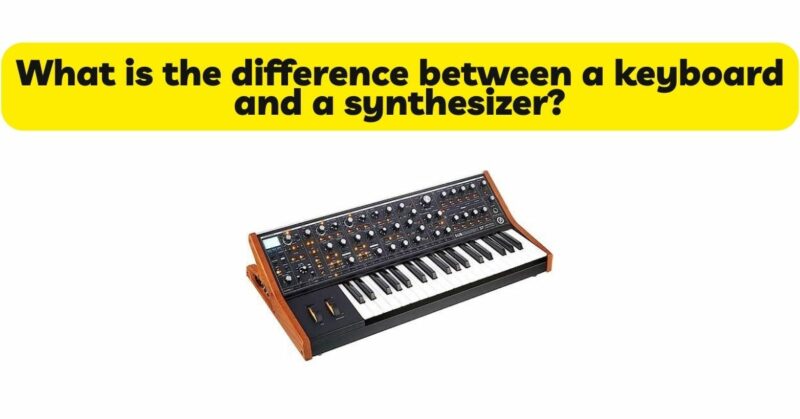In the realm of music production and performance, two terms that are often used interchangeably but possess distinct characteristics are “keyboard” and “synthesizer.” While both devices are capable of generating musical sounds, they serve different purposes and cater to diverse musical needs. This article aims to explore the fundamental differences between keyboards and synthesizers, shedding light on their unique features, functionalities, and applications.
I. Keyboards: A keyboard, at its core, refers to a set of keys arranged in a specific pattern, resembling that of a piano. Keyboards come in various forms, including digital pianos, electronic keyboards, and MIDI controllers. Keyboards are primarily designed to replicate the feel and sound of traditional pianos, with weighted or semi-weighted keys that provide tactile feedback to the musician. They are often equipped with built-in speakers and a wide range of instrument sounds, allowing musicians to explore different tones and timbres.
A. Functionality and Sound:
- Replicating Acoustic Pianos: Keyboards excel at reproducing the sound and playing experience of acoustic pianos, thanks to their weighted keys that offer resistance similar to that of traditional piano keys. The sound generation in keyboards focuses on emulating the distinct characteristics of pianos, including dynamic response and touch sensitivity.
- Sampled Instrument Sounds: Keyboards typically offer a wide selection of sampled instrument sounds, encompassing various pianos, organs, strings, brass, and more. These sounds are pre-recorded and stored digitally, allowing musicians to access a vast library of instruments within a single device.
- Performance and Live Applications: Keyboards are commonly used in live performances, both as standalone instruments and in bands or ensembles. They provide a convenient way to replicate multiple instrument sounds in real-time, making them ideal for playing different parts of a composition.
B. Features and Controls:
- Piano-like Interface: Keyboards resemble pianos in their physical layout, featuring a set of keys arranged in octaves. This familiar layout makes it easier for pianists to transition to keyboard instruments.
- Built-in Effects: Many keyboards come equipped with built-in effects such as reverb, chorus, and modulation, allowing musicians to enhance their sound in real-time.
- Recording and Sequencing: Some keyboards offer basic recording and sequencing capabilities, enabling musicians to create multi-layered compositions and arrangements directly on the instrument.
II. Synthesizers: A synthesizer, often referred to as a synth, is an electronic instrument that generates sound through the manipulation and synthesis of audio signals. Unlike keyboards, synthesizers do not attempt to replicate the sound of acoustic instruments faithfully. Instead, they provide a platform for sound design and exploration, allowing musicians to create entirely new and unique sounds.
A. Sound Generation and Synthesis:
- Oscillators and Waveforms: Synthesizers utilize oscillators to generate basic waveforms, such as sine, square, sawtooth, and triangle. By combining and manipulating these waveforms, synthesists can create complex sounds with varying timbres.
- Sound Design Flexibility: Synthesizers provide extensive sound-shaping capabilities, including envelope generators, filters, LFOs (low-frequency oscillators), and modulation options. These features allow musicians to sculpt and modify sounds to achieve a wide range of sonic possibilities.
- Electronic Sound Manipulation: Synthesizers excel at producing electronic sounds, experimental textures, and unconventional tones that are not typically found in traditional instruments. They are often used in genres like electronic music, ambient, and sound design.
B. Features and Controls:
- Programmability: Synthesizers are highly programmable instruments, enabling users to create their own sounds from scratch or modify existing presets. They offer deep editing capabilities, allowing musicians to tweak every aspect of the sound.
- Performance Controls: Synthesizers often include features like pitch bend wheels, modulation wheels, assignable knobs, and sliders, providing real-time control over various parameters during live performances or studio recordings.
- MIDI Connectivity: Synthesizers are commonly used as MIDI controllers, sending control messages to external devices or software for sound generation. They can be integrated into larger setups for composing, producing, and performing music.
Conclusion: While keyboards and synthesizers share similarities as musical instruments with a set of keys, they differ significantly in terms of functionality, sound generation, and intended applications. Keyboards excel at replicating the sound and playing experience of acoustic pianos, offering a diverse range of sampled instrument sounds. On the other hand, synthesizers prioritize sound design and exploration, allowing musicians to create unique and electronic sounds. Understanding the distinction between keyboards and synthesizers enables musicians to make informed decisions based on their artistic goals and musical requirements, ultimately enhancing their creative endeavors.


